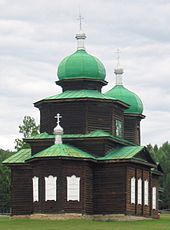Semeiskye
The Semeiskije ( Russian Семейские ; translated as “the family” or “those living in family groups”, from Russian семья , semja for “family”) are a religious community of so-called priestless Old Believers in Transbaikalia , whose ancestors carried out the liturgical reforms of the 17th century Patriarchs had not accepted Nikon and were subsequently exiled to Siberia . Their everyday and spiritual culture was included in 2001 by UNESCO under the name "The cultural area and the oral culture of the Semeisky" in the program " Masterpieces of the Oral and Intangible Heritage of Humanity ", which complements the UNESCO World Heritage .
History and culture

After the recognition of the separation of the Russian Church from the Byzantine Orthodox Church by the Patriarch of Constantinople in 1589, in 1653 Tsar Alexei Mikhailovich and the Archbishop of Novgorod , Patriarch Nikon, began to implement church reform , the main concern of which was to correct the liturgy . Although only formal ritual changes were to be made, widespread opposition arose among both clergy and believers, which led to the split in the Russian Church. The believers who rejected the reforms were called Old Believers (or Raskolniki, from raskol / раско́л “church division”). The emigration and exile of the so-called "Raskolniki" to Siberia led to the Old Believers making up ten percent of the population of Western Siberia. There they mostly led a secluded hermit life.

A small group of Old Believers who now live in southern Buryatia , in the Rajons around the towns of Tarbagatai , Bitschura , Muchorschibir and Saigrajewo in the Transbaikalia region , probably originally lived in Poland before they were relocated to Siberia in the 18th century. In their language, however, both Ukrainian and Belarusian influences can be proven. They kept their village way of life in large families, built new settlements in Buryatia and were given the nickname Semeiskije there. The naturalist and geographer Peter Simon Pallas , as well as the explorers Alexei Iwanowitsch Martos and Matwei Matwejewitsch Gedenstrom described the Semeiskije as successful settlers who lived in neat, brightly painted houses in attractive villages, decorated with lavish carvings.
In the 1930s the Semeisky, like the other groups of Old Believers who lived in the Soviet Union , were suppressed by the state. Their religious leaders were imprisoned and evicted, and their churches, icons and scriptures destroyed. However, the traditional family lifestyle of the Semeisky people also resulted in a relatively successful adaptation to collective farming and other demands of Soviet life. In the 1990s the Semeiskije in some parts of Transbaikalia had changed from a religious group to a predominantly ethnic group, and the connection between the terms “Semeiskije” and “Old Believers” had been lost.
Oral culture of the Semeisky
The main features of the Semeiskije lifestyle have been preserved despite the changes and upheavals of the last century. The real meaning of the spiritual life of the Semeiskije is the preservation of the religious and social order in the connection of people with God, nature and the life of ancestors.
The traditional folklore of the Semeiskije, preserved over several centuries , their costumes, customs, stories, legends, prayers and above all the polyphonic sacred chants are of particular cultural value and interest. The demanding, unmistakable nature of their polyphonic singing becomes a luminous and colorful work of art thanks to the high artistic level of the performance. The chants express the suffering and optimism of a group of people who have preserved both their existence and their spiritual and cultural identity through hard times.
In every village and settlement there is still a group of elderly women today who see to it that the most important Orthodox rituals, baptisms, funeral ceremonies, the prayers for the deceased parents and relatives, and the blessings before significant events in the lives of believers , be carried out according to an ancient custom.
Web links
- German-Russian Liedbrücke
- Photos from the cultural area of the Semeiskie
- World Heritage Site from Siberia
See also
Individual evidence
- ↑ Wladislav Andrejewitsch Ketkowitsch: Cемейские - староверы Забайкалья. (Russian)
- ↑ Alexei Ivanovich Martos (* 1790; † 1842, military writer and traveler in Siberia): Письма о Восточной Сибири , Moscow 1827.
